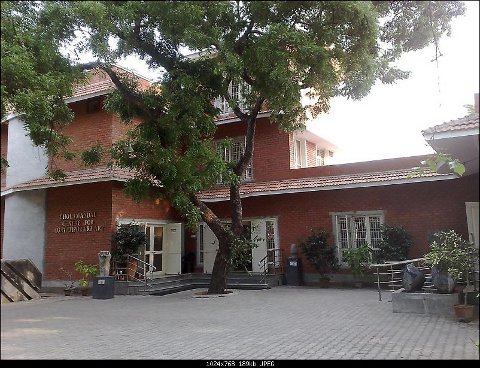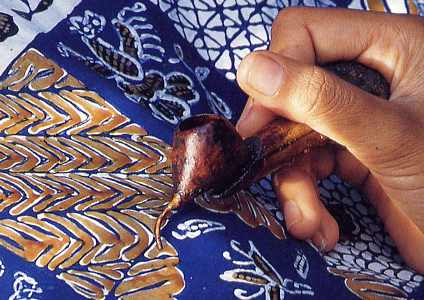Batik is a technique of wax-resist dyeing on cloth which was originated from Indonesia. The word Batik is Javanese in origin( the Indonesian language of central Java).It is believed that the word may either come from the javanese word Amba(to write) and titik(dot) or maybe derived from a hypothetical Proto-Austronesian root ‘becik'(to tattoo). This art of wax-resist dyeing was predominantly developed in the island of Java in Indonesia. Evidences of Batik can also be seen in the Far East, Middle East, Central Asia and also in India from over 2000 years ago. However it is believed that this art spread from Asia to the islands of Malay Archipelago and west to the Middle East through the caravan route. Thus this art has gained popularity world-wide.

Batik in India
Though there are various theories about its origin, the art of Batik in India can be traced to the 1st Century AD. Initially the Khatri community of Gujarat practiced Batik. The beauty of this art is such that it creates visual magic on fabric. In the 20th Century it was introduced as a part of the syllabus in the University of Shanti Niketan in Kolkata. Since then the art has gained more popularity. Batik on fabric can be seen widely in the Chola-Mandal artist’s village in South India(near Chennai) where Batik gets its artistic touch. The Batik produced here is famous for its original designs.


Creation of the art
Batik involves 3 main steps- waxing, dyeing and scraping. This particular art is meticulously done. The final design must be envisioned before the picture is begun. The basic process of Batik is to permeate the area of the fabric with hot wax so that the wax resists the penetration of the dye. Thus Batik is also referred to as wax-resistant dyeing. The fabric holds strong values of arts and cultural influences. Some regions may incorporate their philosophy in the Batik patterns. To appreciate the beauty of the Batik art, one must fully understand the process and techniques involved in making the Batik fabric.
Various Batik Techniques
1.Canting Tulis
The ancient and highly traditional method of Batik is called Canting Tulis. Canting(a small copper or wooden container) with a snout at the end for releasing hot wax is used. The artisans draw the desired designs using the canting and once the process is completed the fabric is dipped in dye around four times. Due to the complexity of this process it takes about one year to create a Batik fabric and this method can be adopted only by skilled craftsmen. The patterns produced through the canting tulis method are very unique and exclusive. Creating a replica is not possible. The intricacy n complexity of the process increases the value of these Batik fabrics. Usually they bear the signature of craftsmen.

2.Printing
Printing is a popular technique in the commercial Batik industry and this method was introduced in the 70’s for mass production. The predetermined computerized designs are printed on the fabric using a printing machine. Batik designs made through printing requires less artistic skills as most of the job is done by the machines. The prints on the fabric are more accurate and detailed and these Batik fabrics are inexpensive compared to the handmade ones.

3.Cap
Cap is similar to the stamping method. A flat base tool is used for this technique. This method is quite simple wherein the molten wax is used to cover the surface area of the stamp and the stamp is pressed onto the fabric with utmost care to ensure neatness of the designs being produced. By using this method more area of the fabric gets equal coverage from the wax. Due to lesser complexity and quick process more fabrics can be made in a day. The Batik fabrics made with the cap process are more affordable.

4.Jumputan
Popularly known as Jumputan or Celup Ikat in Indonesia, this technique uses the tie & dye method where the fabric is tied and dipped into colored liquid and untied to reveal the Batik patterns. Simplicity of the process and due to the fact that it is less time consuming, these fabrics are more affordable. The patterns created through the Jumputan method are distinct, unique and vibrant.

5.Colet
The Colet method of creating Batik is similar to that of painting. The artisans apply the colors on the fabric and use brushes to spread them out. Batik patterns are then drawn on the fabric. This technique is quite complex like the canting tulis and requires skilled craftsmen to create the unique designs. The complex and detailed patterns make the fabric more pricey. We can see that the Javanese Batik fabric making applies this technique. As it is manually done by different people the end designs are unique. The finished fabric is a treat to the eyes.

Batik in clothing and home decor
Cotton and coarse silk fabrics were commonly used for creating Batik designs as they are easily available and absorbs the dyes well. Batik prints are commonly seen on sarees, salwars, kurtas, kurtis and tunics. It is more suited for casual everyday outfits. Nowadays stoles scarves and other women’s accessories like handbags and purses can be seen in vibrant Batik designs. Needless to say that we also use Batik in our home decor as well in the form of murals, wall hangings, cushion covers and rugs.



Acknowledgement
In October 2009, Indonesian Batik was designated by UNESCO as a Masterpiece of Oral and Intangible Heritage of Humanity.
References:
https://en.wikipedia.org/wiki/Batik
http://www.india-crafts.com/textile/printing_tradition/batik/
